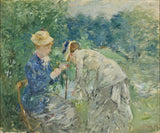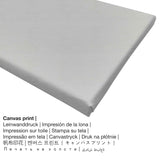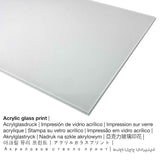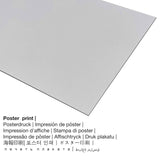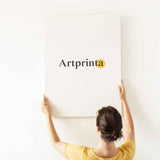Berthe Morisot, 1880 - Na Bois de Boulogne - ọmarịcha nka
Ụtụ gụnyere. Mbupu gbakọrọ na ndenye ọpụpụ.
Ihe ndị a na-ahọrọ
The product dropdown menu gives you the possibility to pick your prefered material and size. You can choose your your favorite size and material among the following options:
- Mbipụta kanvas: A UV printed canvas mounted on a wood stretcher frame. It has a extra effect of three-dimensionality. In addition to that, a canvas creates a lively and positive look. Your printed canvas of this work of art will let you turn your fine art print into a large size artpiece as you would see in a gallery. Canvas prints are relatively low in weight, which implies that it is easy to hang up the Canvas print without the support of additional wall-mounts. Because of thata canvas print is suited for any type of wall.
- Mbipụta nke aluminom: An Aluminium Dibond print is a material with an impressive depth effect. Its non-reflective surface make a fashionable impression. The Direct Print on Aluminum Dibond is your perfect start to the sophisticated world of fine prints with aluminum. The white & bright parts of the artpiece shine with a silk gloss but without glow. The colors of the print are vivid and luminous in the highest definition, details appear very clear. This UV print on Aluminum Dibond is the most popular entry-level product and is an extremely sophisticated way to display artworks, as it draws focus on the whole artwork.
- Mbipụta akwụkwọ mmado (akwa akwa akwa): The poster print is a printed canvas paper with a slightly rough surface texture. Please bear in mind, that depending on the absolute size of the poster print we add a white margin of something between 2-6cm around the painting, which facilitates the framing with your custom frame.
- Bipụta na iko acrylic na-egbuke egbuke (nke nwere ezigbo mkpuchi iko): An print on acrylic glass, often named a print on plexiglass, transforms your favorite original into wonderful décor and forms a good alternative to canvas or dibond art prints. The work of art will be manufactured thanks to state-of-the-art UV direct printing technology. This has the effect of rich, impressive colors. With an acrylic glass art print contrasts and smaller color details become visible thanks to the very subtle gradation in the print. Our plexiglass protects your chosen fine art print against light and external influences for many decades.
Nkwupụta iwu: We try in order to describe our art products as closely as it is possible and to exhibit them visually in our shop. Please bear in mind that the pigments of the printing material, as well as the printing can diverge marginally from the image on the screen. Depending on the settings of your screen and the quality of the surface, not all color pigments are printed as realisitcally as the digital version on this website. Considering that all our art reproductions are processed and printed by hand, there might also be slight variations in the motif's exact position and the size.
Artwork specifications by the museum (© Copyright - by Nationalmuseum Stockholm - National Museum nke Stockholm)
English: Berthe Morisot took part in the first Impressionist exhibition in 1874, and since then belonged to the core of the group. Contemporary reviewers described her paintings as the very essence of Impressionism. Many critics regarded the group’s style to be exceedingly feminine – the sketchy character, the focus on colour rather than outline, the emphasis on transience and the fleeting moment – and therefore found Morisot’s technique to be quite suitable for a woman. At the Impressionist exhibition in 1880, she showed twelve paintings, including this one. Berthe Morisot hade sedan impressionistgruppens första utställning 1874 tillhört gruppens kärnkrets. Hon deltog vid flera tillfällen aktivt i arrangerandet av utställningarna. Hennes måleri uppfattades av flera kritiker som själva essensen av impressionismen. På impressionisternas utställning 1880 ställde hon ut tolv verk. En av de utställda målningarna var "I Boulognerskogen", som visades under titeln "Au jardin". Utställningen fick som helhet tämligen negativ kritik, vilket har betraktats som ett tecken på den kris impressionismen gått in i mot slutet av 1870-talet. Morisot var en av de konstnärer som fick störst uppmärksamhet i recensionerna. Kritikerna lyfte fram hennes djärva och skissartade målningssätt. Några av dem jämförde också hennes måleri med den franske 1700-talsmålaren Honoré Fragonards skissartade och flödiga teknik. Flera av kritikerna uppfattade Morisot som den enda egentliga impressionisten på utställningen. En orsak till detta var att flera av de ledande namnen inom gruppen - Monet, Renoir och Sisley - avstått från att delta i utställningen. Morisots konst betraktades ofta som utpräglat feminin. Som konsthistorikern Tamar Garb har visat kom även impressionismen som stil med tiden att betraktas som feminin. Det impressionistiska målningssättet - det skissartade, betoningen av färg snarare än form, betoningen av det flyktiga och tillfälliga - uppfattades som kvinnligt. Att Morisot målade så utpräglat impressionistiskt ansågs därför ofta som passande. Hennes teknik var helt enkelt lämplig för en kvinna. Kvinnor vars målningar uppvisade andra egenskaper - egenskaper som kunde kallas manliga - fick inte sällan kritik för att de arbetade på ett sätt som stred mot deras kvinnliga natur. De kunde också beskyllas för att endast försöka efterlikna sina manliga förebilder och lärare.
Nchịkọta ngwaahịa
This over 140 year-old painting named "In the Bois de Boulogne" was painted by the impressionist painter Berthe Morisot na 1880. The 140 year old work of art measures the dimensions - Ogologo: 61 cm (24 ″); Obosara: 73,5 cm (28,9 ″) Ekebere: Elu: 82 cm (32,2 ″); Obosara: 96 cm (37,7 ″); Omimi: 11 cm (4,3 ″). Mmanụ na kwaaji was applied by the European painter as the medium of the piece of art. It belongs to the National Museum nke Stockholm nchịkọta dijitalụ. Site n'ikike nke - Nationalmuseum Stockholm & Wikimedia Commons (ikike - ngalaba ọha).: . Ọzọkwa, nhazi nke mmepụta dijitalụ bụ odida obodo ma nwee akụkụ nke 1.2: 1, nke pụtara na ogologo bụ 20% ogologo karịa obosara. Berthe Morisot was a painter, whose artistic style can be attributed mainly to Impressionism. The Impressionist painter was born in the year 1841 in Bourges, Centre region, France and deceased at the age of 54 na 1895.
Data ndabere gbasara akụkụ nka pụrụ iche
| Aha eserese: | "In the Bois de Boulogne" |
| Nhazi nka nka: | sere |
| Otu sara mbara: | nkà nke oge a |
| Nhazi oge: | 19th narị afọ |
| Ekepụtara: | 1880 |
| Afọ nka: | karịa afọ 140 |
| Usoro nka izizi: | mmanụ na kwaaji |
| Nha izizi: | Ogologo: 61 cm (24 ″); Obosara: 73,5 cm (28,9 ″) Ekebere: Elu: 82 cm (32,2 ″); Obosara: 96 cm (37,7 ″); Omimi: 11 cm (4,3 ″) |
| Ụlọ ihe ngosi nka: | National Museum nke Stockholm |
| Ebe ngosi nka: | Stockholm, Obodo Stockholm, Sweden |
| E Nwere na: | www.nationalmuseum.se |
| Akwụkwọ ikike nka: | ngalaba ọha |
| Site n'aka: | Nationalmuseum Stockholm na Wikimedia Commons |
Nkọwa ngwaahịa
| Nkewa ngwaahịa: | ọmarịcha nka |
| Usoro mmeghari: | dijitalụ mmeputakwa |
| Usoro nhazi: | mbipụta dijitalụ |
| Ihe ngosi: | arụpụtara na Germany |
| Stockdị ngwaahịa: | mmepụta ihe na-achọ |
| Eji ngwaahịa emebere: | nchịkọta nka (mmeputakwa), ihe ndozi ụlọ |
| Ndepụta: | nhazi odida obodo |
| Njikwa oyiyi: | 1.2: 1 |
| Mmetụta akụkụ onyonyo: | ogologo bụ 20% ogologo karịa obosara |
| Nhọrọ akwa: | ígwè obibi akwụkwọ (aluminium dibond), ebipụta canvas, mbipụta enyo acrylic (nwere ezigbo mkpuchi iko), mbipụta akwụkwọ mmado (akwụkwọ kwaaji) |
| Canvas dị n'elu ihe nrịbama (mbipụta kanvas) nha dị iche iche: | 60x50cm - 24x20", 120x100cm - 47x39", 180x150cm - 71x59" |
| Mpempe iko acrylic (nwere ezigbo mkpuchi iko) nha: | 60x50cm - 24x20", 120x100cm - 47x39", 180x150cm - 71x59" |
| Ụdị akwụkwọ mmado (akwụkwọ kwaaji) dị iche iche: | 60x50cm - 24x20", 120x100cm - 47x39" |
| Mbipụta nke aluminom: | 60x50cm - 24x20", 120x100cm - 47x39" |
| ụba: | na-enweghị etiti |
Nchịkọta ihe nkiri
| aha: | Berthe Morisot |
| Aha ndi ozo: | Manet Berthe Marie Pauline Morisot, מוריסו ברת', Morisot Berthe Marie Pauline, B. Morisot, Berthe Morisot, Morisot Berthe Manet, Berthe Manet, Morisot Berthe-Marie-Pauline, Berthe Marie Pauline Morisot, Morisot, Morisot Berthe |
| okike nke onye nka: | nwanyi |
| Obodo onye nka: | French |
| Ọrụ onye na-ese ihe: | onye na-ese ihe |
| Mba onye si: | France |
| Nhazi nke onye nka: | omenkà nke oge a |
| Ụdị nke onye na-ese ihe: | Mmetụta |
| Afọ ọnwụ: | 54 afọ |
| A mụrụ: | 1841 |
| Ebe omuma: | Bourges, mpaghara Center, France |
| Nwụrụ n'afọ: | 1895 |
| Obodo ọnwụ: | Paris, Ile-de-France, France |
© Nwebiisinka nke, Artprinta (www.artprinta.com)

